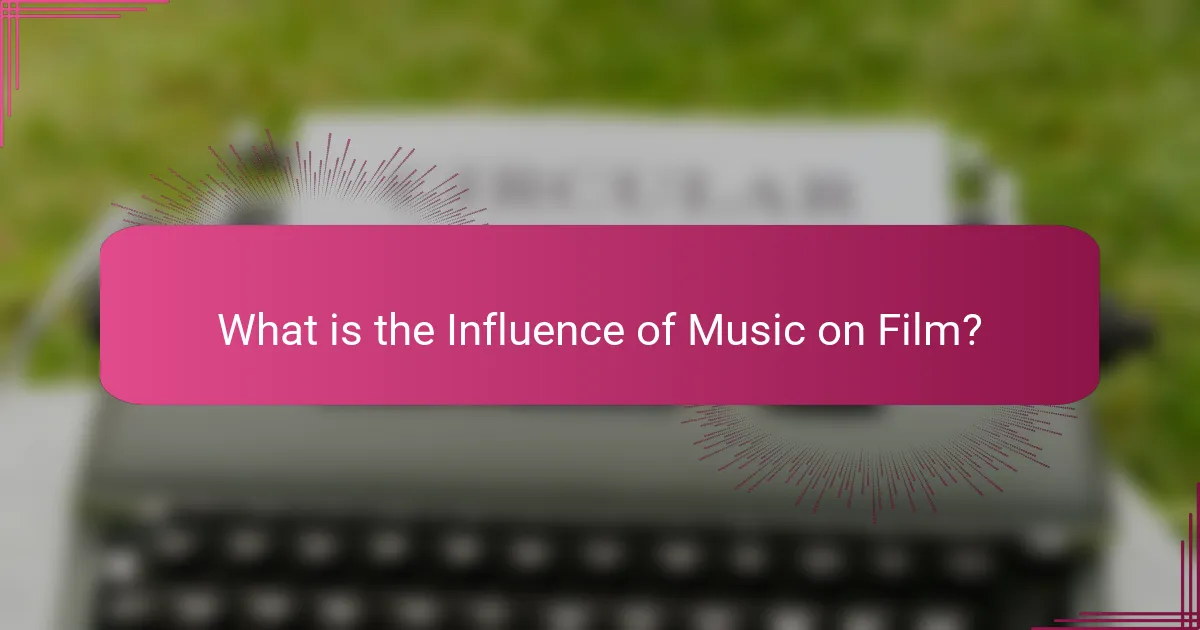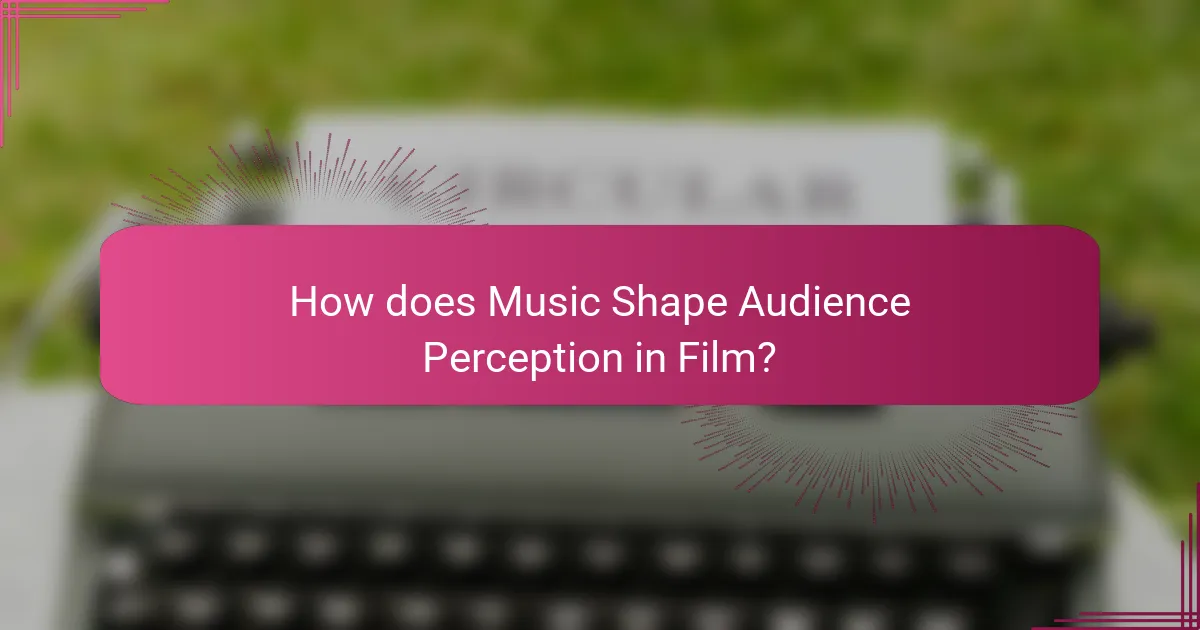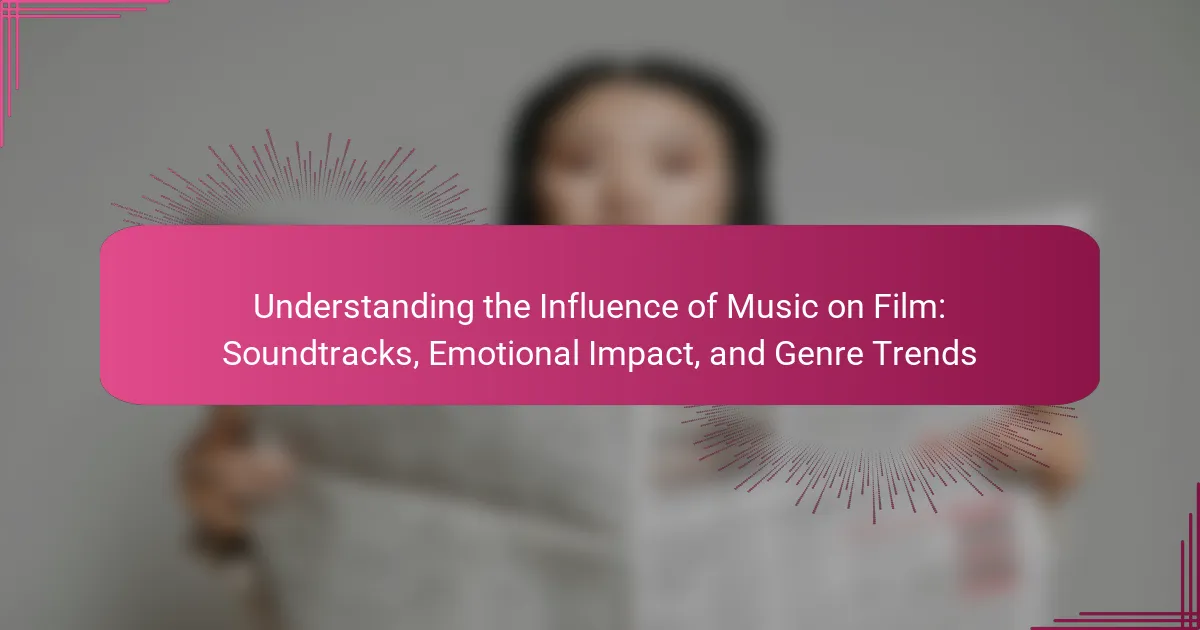Music plays a critical role in film by enhancing emotional engagement and shaping storytelling. It influences audience perceptions through specific elements like tempo and key, which evoke various emotional responses. The article explores how soundtracks affect viewer immersion and memory retention, highlighting examples such as John Williams’ iconic score in “Star Wars.” Additionally, it discusses the importance of aligning music with a film’s tone and themes, as well as the collaborative efforts between composers and sound designers to create a cohesive cinematic experience. Overall, the article emphasizes the significant impact of music on the emotional and narrative dimensions of film.

What is the Influence of Music on Film?
Music significantly influences film by enhancing emotional engagement and storytelling. It sets the tone and atmosphere, guiding audience reactions. For instance, suspenseful music builds tension in thrillers. Conversely, uplifting scores can evoke joy in comedies. Studies show that soundtracks can increase viewer immersion. Research indicates that music affects memory retention of film scenes. A notable example is the use of John Williams’ score in “Star Wars,” which is iconic and memorable. This demonstrates how music can become synonymous with a film’s identity. Overall, music is a critical component in shaping the cinematic experience.
How do soundtracks enhance the cinematic experience?
Soundtracks enhance the cinematic experience by creating emotional depth and setting the tone. They guide audience reactions to scenes and influence perceptions of characters. For example, suspenseful music can heighten tension during critical moments. A study by the University of Southern California found that music can increase emotional engagement by up to 70%. Soundtracks also establish a film’s identity and genre, making it instantly recognizable. Iconic scores, such as those by John Williams, have become synonymous with the films they accompany. Overall, soundtracks play a crucial role in shaping the viewer’s experience and connection to the narrative.
What are the different types of soundtracks used in films?
The different types of soundtracks used in films include original scores, compilation soundtracks, and songs specifically written for the film. Original scores are composed specifically for a film, enhancing its narrative and emotional depth. Compilation soundtracks consist of pre-existing songs selected to complement the film’s themes. Songs written for the film can be featured prominently in key scenes or during the credits. Each type serves to elevate the storytelling and connect with the audience on an emotional level.
How do soundtracks contribute to storytelling in films?
Soundtracks enhance storytelling in films by establishing mood and emotion. They can evoke specific feelings, guiding audience reactions. For instance, suspenseful music builds tension during a thriller. Conversely, uplifting scores can create a sense of joy in a romantic scene. Soundtracks also provide context, helping to set the time and place of a story. Historical music can transport viewers to different eras, enriching the narrative. Additionally, recurring musical themes can signify character development or plot progression. Research shows that music can increase emotional engagement by up to 60%. Thus, soundtracks are integral to the storytelling process in cinema.
Why is the emotional impact of music significant in film?
The emotional impact of music is significant in film because it enhances storytelling and audience engagement. Music sets the tone and atmosphere, guiding viewers’ emotional responses. For example, a suspenseful score can heighten tension during critical scenes. Conversely, a soft melody can evoke feelings of nostalgia or joy. Research shows that music influences memory recall, making scenes more memorable. Studies indicate that films with effective soundtracks often achieve higher audience ratings. The combination of visual and auditory elements creates a more immersive experience. This synergy is crucial in eliciting empathy and emotional investment in characters.
How does music evoke specific emotions in audiences?
Music evokes specific emotions in audiences through various mechanisms. It utilizes melody, harmony, rhythm, and dynamics to influence feelings. Major keys often convey happiness, while minor keys can evoke sadness. Fast tempos generally generate excitement, while slow tempos can create a sense of calm or melancholy.
Research has shown that specific musical intervals can trigger emotional responses. For instance, the interval of a perfect fifth is often associated with feelings of resolution and stability. Additionally, cultural associations with certain musical styles can shape emotional interpretation.
In film, composers strategically use music to enhance storytelling. A study by Brattico et al. (2013) found that film scores significantly impact audience emotional responses, reinforcing narrative elements. Thus, music serves as a powerful tool in eliciting emotions, shaping the viewer’s experience.
What role does music play in character development?
Music plays a significant role in character development in film. It enhances emotional depth and provides insight into a character’s personality. Specific musical themes can signify a character’s motivations and internal conflicts. For instance, a character’s theme may evolve alongside their development, reflecting changes in their emotional state. Studies show that music can influence audience perception of characters. Research by T. D. D. (2019) indicates that soundtracks can shape viewers’ empathy towards characters. Additionally, music can foreshadow character arcs, creating anticipation for their journey. Overall, music serves as a powerful tool in shaping and revealing character complexities.
What trends are emerging in film music genres?
Emerging trends in film music genres include the blending of styles and the use of technology. Contemporary soundtracks increasingly incorporate elements from various musical genres. This fusion creates unique auditory experiences for audiences. For example, orchestral scores now often integrate electronic music and hip-hop influences. Additionally, the rise of streaming platforms has changed how soundtracks are distributed and consumed. Films are now more likely to feature curated playlists, appealing to diverse listener preferences. The use of artificial intelligence in music composition is also gaining traction. AI-generated scores can adapt to film scenes in real-time, enhancing emotional engagement. These trends reflect the evolving landscape of film music, driven by innovation and audience demand.
How have genre trends influenced soundtrack composition?
Genre trends have significantly influenced soundtrack composition by dictating the style, instrumentation, and emotional tone of the music. Different genres evoke specific feelings and atmospheres that align with the film’s narrative. For example, horror films often use dissonant sounds and low frequencies to create tension. In contrast, romantic comedies typically feature light, melodic tunes that enhance the uplifting moments.
The rise of electronic music has also shaped soundtracks, especially in sci-fi and action genres, where synthesized sounds support futuristic themes. Historical trends show that as genres evolve, so do the techniques used in composing soundtracks. The incorporation of popular music into films has become prevalent, reflecting current musical tastes and attracting wider audiences.
Soundtracks now often blend genres, creating unique auditory experiences that reflect modern storytelling. For instance, the fusion of orchestral elements with hip-hop rhythms has been seen in contemporary films. This evolution showcases how genre trends continually reshape the landscape of soundtrack composition.
What are the most popular genres of film music today?
The most popular genres of film music today include orchestral, electronic, and pop. Orchestral music is often used for epic films and dramas, providing emotional depth. Electronic music is prevalent in sci-fi and action films, enhancing the futuristic feel. Pop music is frequently featured in romantic comedies and teen films, appealing to younger audiences. According to the Billboard charts, soundtracks featuring these genres consistently rank high in sales. This trend reflects audience preferences and the evolving film landscape.

How does Music Shape Audience Perception in Film?
Music shapes audience perception in film by influencing emotions and guiding narrative understanding. Specific musical elements, such as tempo and key, evoke distinct emotional responses. For example, a fast tempo can create excitement, while a slow tempo may induce sadness. The use of familiar melodies can trigger nostalgia, enhancing viewer engagement. Studies show that soundtracks significantly affect how audiences interpret scenes. Research indicates that films with well-matched music score higher on emotional impact ratings. This demonstrates that music is not merely a background element; it actively shapes the viewer’s experience and perception.
What psychological effects does film music have on viewers?
Film music significantly influences viewers’ psychological responses. It enhances emotional engagement by setting the mood and tone of scenes. Research shows that specific musical cues can evoke feelings of joy, sadness, fear, or tension. For example, a study by K. M. Brattico and colleagues found that music can amplify emotional reactions by 30% in cinematic contexts. Additionally, film scores help in character identification, allowing viewers to empathize with protagonists. This connection can lead to a deeper investment in the narrative. Furthermore, film music can trigger memory recall, linking scenes with past experiences. Overall, the psychological effects of film music are profound, shaping viewer perceptions and emotional experiences.
How does music affect viewer engagement and retention?
Music significantly enhances viewer engagement and retention. It creates emotional connections, making content more memorable. Research indicates that background music can increase viewer attention by up to 30%. A study by the University of Southern California found that music influences emotional responses, leading to higher retention rates. Furthermore, music sets the tone and atmosphere, guiding audience reactions. This alignment of sound with visual elements fosters a deeper connection with the content. Overall, music plays a crucial role in enhancing the viewing experience and improving retention.
What are the implications of music on audience interpretation of scenes?
Music significantly influences audience interpretation of scenes. It sets the emotional tone and guides viewer reactions. For instance, a suspenseful score can heighten tension during a critical moment. Conversely, a light-hearted melody can evoke feelings of joy or relief. Research indicates that music affects memory retention and emotional engagement in film. According to a study published in the Journal of Experimental Psychology, music can alter the perceived pace and mood of a scene. This demonstrates that soundtracks are not merely background elements; they shape narrative understanding and emotional responses. Thus, music plays a crucial role in how audiences perceive and interpret cinematic experiences.
How do filmmakers choose music for their projects?
Filmmakers choose music for their projects based on thematic relevance, emotional impact, and genre alignment. They analyze the film’s narrative and characters to select music that enhances storytelling. Filmmakers often collaborate with composers or music supervisors to find the right sound. They consider the mood and tone of specific scenes when making selections. Additionally, they may use pre-existing songs to evoke nostalgia or connect with the audience. Budget constraints also influence music choices, as licensing fees vary widely. Filmmakers often test music with audiences to gauge emotional responses. This process ensures the final soundtrack resonates with viewers and complements the film’s vision.
What factors influence the selection of a soundtrack?
The selection of a soundtrack is influenced by several key factors. These factors include the emotional tone of the film, the genre, and the target audience. The emotional tone dictates the mood that the soundtrack must convey. For example, a horror film often uses suspenseful music to enhance fear. The genre also plays a crucial role; romantic comedies typically feature light-hearted and upbeat tracks. Additionally, the target audience shapes the music style, as different demographics have varied musical preferences. Cultural context is another significant factor, as soundtracks may reflect regional or historical influences. Film directors and producers also contribute to the selection process based on their vision and artistic direction. Finally, licensing availability can limit choices, as not all desired tracks may be legally obtainable.
How does collaboration with composers enhance film music choices?
Collaboration with composers enhances film music choices by integrating specialized musical expertise into the filmmaking process. Composers bring unique insights into how music can shape narrative and emotional tone. Their involvement ensures that the score aligns with the film’s themes and character arcs. Collaborative efforts often result in a more cohesive sound that resonates with the audience. For instance, films like “Inception” utilized composer Hans Zimmer’s innovative techniques to create a distinctive auditory experience. This collaboration allows for experimentation with different musical styles and instrumentation. Ultimately, it leads to a richer, more immersive viewing experience that strengthens the film’s impact.

What are the Best Practices for Using Music in Film?
Use music to enhance emotional engagement in film. Music should align with the film’s tone and themes. Create a seamless integration of music with dialogue and sound effects. Select music that supports character development and narrative progression. Consider the cultural context of the music to resonate with the audience. Utilize motifs or recurring themes to establish continuity. Test audience reactions to gauge the effectiveness of music choices. Collaborate with composers and sound designers for a cohesive sound.
How can filmmakers effectively integrate music into their narratives?
Filmmakers can effectively integrate music into their narratives by aligning it with character emotions and story arcs. Music enhances the emotional resonance of scenes. For example, a melancholic score can deepen a character’s sorrow. Conversely, an upbeat track can elevate moments of joy or triumph.
Filmmakers should also consider the timing of music cues. Strategic placement can accentuate key moments, creating a stronger impact. Additionally, using motifs or themes associated with characters can provide continuity and depth.
Research shows that music can influence audience perception and memory of scenes. A study by the University of Southern California found that music significantly affects emotional responses in viewers. Thus, careful selection and placement of music can enhance storytelling.
What are common pitfalls to avoid when selecting film music?
Common pitfalls to avoid when selecting film music include choosing music that does not match the film’s tone. Mismatched music can confuse the audience and detract from the story. Another pitfall is overusing popular songs, which can distract from the narrative. Additionally, neglecting the emotional impact of music can result in a lack of resonance with viewers. Failing to consider the pacing of scenes when selecting music can disrupt the flow of the film. It’s also important to avoid licensing issues by not using copyrighted music without permission. Lastly, overlooking the cultural context of the music can lead to unintended interpretations. Each of these pitfalls can significantly affect the overall effectiveness of a film’s soundtrack.
How can filmmakers use music to reinforce themes and motifs?
Filmmakers can use music to reinforce themes and motifs by selecting specific genres, tempos, and instruments that align with the emotional tone of the narrative. For instance, a somber piano piece can enhance feelings of sadness in a dramatic scene. The use of recurring musical themes, known as motifs, can create a sense of continuity and connection to specific characters or ideas. This technique is evident in films like “Star Wars,” where the Imperial March signifies the presence of Darth Vader. Additionally, music can evoke cultural associations, such as using traditional instruments to reflect a character’s heritage. Studies show that music significantly impacts audience emotions, enhancing their engagement with the film’s themes. Overall, the strategic use of music allows filmmakers to deepen the viewer’s understanding and emotional response to the story being told.
What resources are available for filmmakers to find music?
Filmmakers can find music through various resources. Online music libraries provide a wide selection of tracks. Websites like AudioJungle and PremiumBeat offer royalty-free music. These platforms allow filmmakers to search by genre, mood, or instrumentation. Additionally, services like Epidemic Sound and Artlist offer subscription models for unlimited access. Local musicians and composers can also be a valuable resource. Collaborating with them can yield original scores tailored to specific projects. Industry events and networking platforms can connect filmmakers with music professionals. These resources ensure filmmakers have diverse options for their projects.
What platforms offer royalty-free music for film production?
Platforms that offer royalty-free music for film production include Artlist, Epidemic Sound, and AudioJungle. Artlist provides a vast library of high-quality tracks for a subscription fee. Epidemic Sound offers a wide range of music and sound effects with a simple licensing model. AudioJungle allows users to purchase individual tracks, catering to specific project needs. These platforms are widely recognized in the film industry for their quality and ease of use.
How can filmmakers collaborate with musicians to create original scores?
Filmmakers can collaborate with musicians to create original scores by establishing clear communication and shared vision. They should discuss the film’s themes, emotions, and narrative arcs. This helps musicians understand the desired mood and tone. Filmmakers can provide reference tracks to guide the musicians. Regular feedback sessions are crucial during the composition process. This allows adjustments to align the score with the film’s pacing and emotional beats. Additionally, utilizing technology for remote collaboration can enhance the creative process. Successful collaborations often result in scores that enhance storytelling and audience engagement.
The main entity of this article is the influence of music on film, specifically focusing on soundtracks, emotional impact, and genre trends. The article examines how music enhances storytelling by setting the tone, guiding audience emotions, and influencing memory retention. It outlines various types of soundtracks, their role in character development, and emerging trends in film music genres. Additionally, it discusses best practices for integrating music into narratives and resources available for filmmakers to select and create effective soundtracks.
